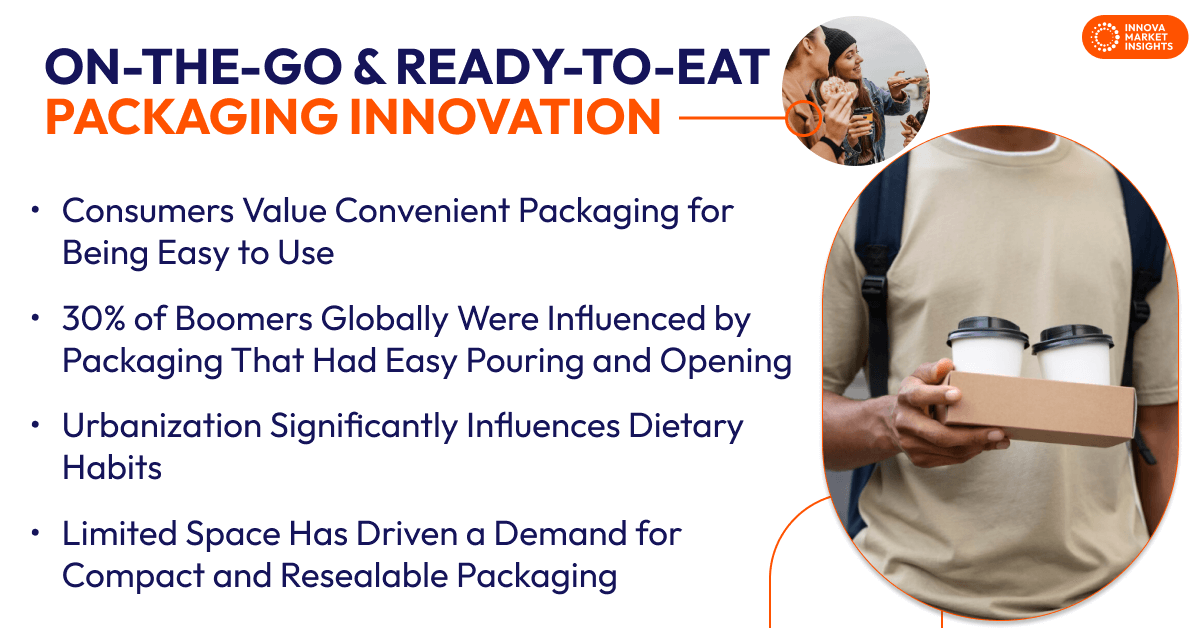October 9, 2025 – Busier than ever, consumers have so many commitments to attend to and take care of. From work to family, social to unexpected occasions, the aging consumer base is in need of on-the-go and ready-to-eat packaging formats that complement their lifestyles, not hinder them. For packaging features to meet demand, brands need to meet consumers where they are and how they want to engage with their products for real adoption driven by cost-effective solutions. Innova Market Insights has made a report with extensive views and analysis to understand what consumers value most about convenience packaging, and also how their expectations and needs vary between generations.
Are People Willing to Pay More for Convenient Packaging?
Consumers value convenient packaging for the ease of use, while portability is also an added bonus. These expectations are the norm, and if the price for them is too high, it can deter many from purchasing. This price sensitivity is largely due to issues around the cost of living and inflation. Innova Market Insights observed that many brands offer user-friendly packaging at no extra cost, meaning that consumers can opt for cheaper alternatives if necessary. For 91% of consumers globally, convenience claims were somewhat influential in their purchasing decisions when buying food and beverages, and 16% of them said that convenience was worth paying more for.
Can Value Be Added With Premium On-the-Go Features?
To be premium, a product has to have something special in its makeup. Consumers are convinced that uniqueness has a particular role to play, with novelty around packaging for out-of-home consumption being key to price justification. Lightweight formats, for instance, can be both sturdy and easy to carry convenient meals or drinks, with 26% of consumers globally being prepared to pay more for packaging that was easy to consume on the go. They also want suitable eating utensils included, which have been shown to often be a deciding factor in the purchase of ready-to-eat lunches and dinner options. One other factor that can justify premium prices is the ability to regulate the temperature of the food or beverage through packaging. Interestingly, half of the global research respondents were either not at all familiar or only slightly familiar with self-heating or cooling packaging, leaving room for opportunity.
How Can Brands Cater to an Aging Consumer Base?
There is an ergonomic handling design that packaging needs to possess. This can be in the form of spouts or lids that are easy to open, or in the form of handles that do not succumb to the heat if popped into the microwave. For those with less dexterity, specifically adapted screwable tops or caps are preferable. More precisely, around the topic of size, there is a demand for single-serve and small-size offerings to cut down on food waste and preserve freshness, particularly among Boomers whose families may have moved out and into their own abodes. In fact, Innova Market Insights found that 30% of Boomers globally were influenced in their purchasing decisions by packaging that had easy pouring and opening functions.

Can Food Waste Reduction Features Offer Value for Money?
Time saving and waste reduction are important to people. For 30% of consumers globally, their main environmental concern related to packaging is food waste. Even more so if they provide substantial value for money. Clarity and transparency are appreciated, making a difference for consumers. This also extends to the type of packaging, which, if it has a transparent cover or lid can easily indicate to the person eating or drinking how much is left and avoid unnecessary waste. If packaging is easy to open without the need for scissors or a similar tool, it offers a neater alternative.
Is Convenience Favored Over Aesthetics in On-the-Go and Ready-to-Eat Formats?
Urbanization significantly influences dietary habits, therefore creating increased demand for convenience. For around 20% of respondents in this report, they said that it was the most influential when buying food and beverages, and that rose to 40% when at home. Longer commutes, less predictable working hours, and more out-of-home activities mean less time and energy for food preparation. Opportunities exist for increased variety and quality of convenience food offerings in meal kits, frozen meals, and ready-to-eat options. The world of work has changed somewhat in the past few years, and the rise of hybrid or remote work has reduced the dependence on takeaways to meet consumer needs. It also has an impact on their budgets, with 54% saying that cost and value for money were the most important when consuming food at home
How Much Influence Does Convenience Have Over Different Generations?
Research found that 90% of those studied view convenience claims as at least somewhat influential. This is particularly true for younger generations, with almost half of Generation Z and half of Millennials finding convenience claims to be effective. Snacking and eating-on-the-go culture is strong among the younger generations across categories, and compared to the likes of Boomers, these claims influence them. Budget and quality have a significant role in the mindset of those who consider convenient food as good value. With rising prices and economic pressure, consumers have to be conscious about what they buy. For many, cooking at home is a more cost-effective alternative, even if it takes more time. Advances in smart kitchen machines like air fryers, instant pots, and rice cookers are also making home cooking faster and easier. For a quarter of consumers, time saving is just as important to those who favor on-the-go consumption who do the same thing outdoors. Resealable, single-serve, and spill-proof packaging is preferred for traveling, commuting, hiking or just eating and drinking stress-free.
What Are the Most Sought-After Convenience Features?
Limited space in some houses has driven a demand for compact, stackable, and resealable packaging. This is more appealing as consumers want quick and effortless access to food and beverages, especially for busy mornings, meal prep and family meals. Portion-controlled packaging, such as single-serve yogurt, makes storage in the refrigerator easier for instance. Demographically, Boomers are health-conscious and focus on calories, sugar reduction and portion control, so resealable or single-serve are more enticing to them. About a third of consumers globally say that convenience attributes influence purchasing decisions when buying ready meals or salty snacks, and the increase in demand is something brands should take note of.
What Is Best for Portion Control, Improved User Experience, and Slashing Waste?
The most effective way to curb waste, manage portions, and appeal to shoppers is with easy-to-use packaging to remove or reduce stress and instill a mindset that favors quick to prepare and consume. This trend is particularly strong in liquid, semi-liquid and granular foods where easy spout closures help reduce spills and drips. More brands are using this kind of packaging for products such as yogurt, honey and condiments for which precision pouring matters. Toothpaste-style tubes for spreads, sauces, purees, and so on are more common now, and this shift is all part of the wider demand for simple food packaging without much waste.
What’s Next for Trends in On-the-Go and Ready-to-Eat Formats Globally?
While a lot of younger generations have been prominent in this report, the gap exists and will lead to targeting packaging in the on-the-go market for older or elderly consumers. Trends around preparation and efficiency are likely to accelerate, and new forms of packaging innovation will take hold. Products designed specifically for on-the-go occasions with value-adding extras like well-designed eating utensils. Spill proof and easy-to-dispense packs that render on-the-go offerings like salads, sandwiches, and hot drinks will be unique, continuing to evolve at the same time. While variety and multipacks of single-serve and small-size portions that can maximize storage for households of all sizes will also be developed, with a niche focus on waste reduction included.
This article is based on Innova’s The Shift Toward Convenient Packaging: Trends in On-the-Go & Ready-to-Eat Formats – Global report. This report is available to purchase or with an Innova Reports subscription. Reach out to find out more
